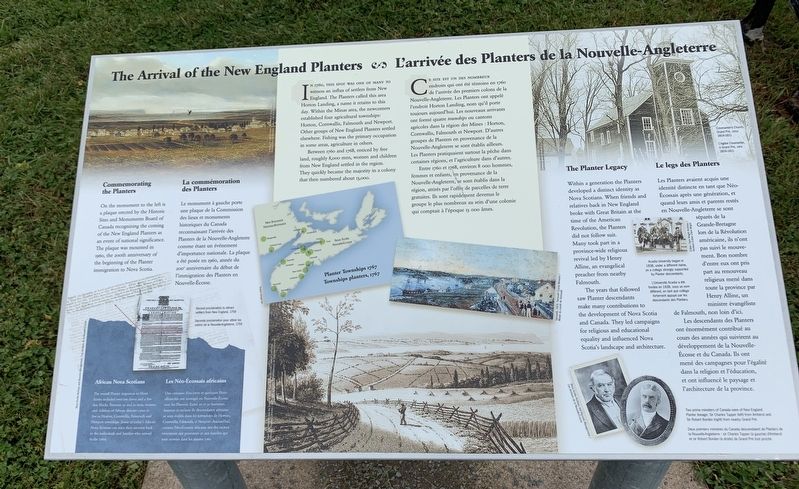Horton Landing in Kings County, Nova Scotia — The Atlantic Provinces (North America)
The Arrival of the New England Planters/L'arrivée des Planters de la Nouvelle-Angleterre
In the 1760’s, this spot was one of many to witness an influx of settlers from New England. The Planters called this region Horton Landing, a name it retains to this day. Within the Minas area, the newcomers established four agricultural townships: Horton, Cornwallis, Falmouth, and Newport. Other groups of Planters settled elsewhere. Fishing was the primary occupation in some areas, agriculture in others.
Between 1760 and 1768, enticed by free land, roughly 8,000 men, women and children from New England settled in the region. They quickly became the majority in a colony that then numbered about 13,000.
Upper left inset:
Commemorating the Planters
On the monument to the left is a plaque erected by the Historic Sites and Monuments Board of Canada recognizing the coming of the New England Planters as an event of national significance. The plaque was mounted in 1960, the 200th anniversary of the beginning of the Planter immigration to Nova Scotia.
Lower left inset:
African Nova Scotians
The overall Planter immigration to Nova Scotia included over 100 slaves and a few free Blacks. Between 20 and 30 men, women and children of African descent came to live in Horton, Cornwallis, Falmouth, and Newport townships. Some of today’s African Nova Scotians can trace their ancestry back to the individuals and families who arrived in the 1760’s.
Right inset:
The Planter Legacy
Within a generation the Planters developed a distinct identity as Nova Scotians. When friends and relatives back in in New England broke with Great Britain at the time of the American Revolution, the Planters did not follow suit. Many took part in a province-wide religious revival led by Henry Alline, an evangelical preacher from nearby Falmouth.
The years that followed saw Planter descendants make many contributions to the development of Nova Scotia and Canada. They led the campaign for religious and educational equality and influenced Nova Scotia’s landscape and architecture.
Entre 1760 et 1768, environ 8 000 hommes, femmes et enfants, en provenance de la Nouvelle-Angleterre se sont établis dans la région, attirés par des terres gratuites. Ils sont rapidement devenus le groupe le plus nombreux au sein d’une colonie qui comptait à l’époque 13 000 âmes.
Encart supérieur gauche:
La commémoration des Planters
Le monument à gauche porte une plaque de la Commission des lieux et monuments historiques du Canada, reconnaissant l’arrivee des Planters de la Nouvelle-Angleterre comme etant un en événement d'importance nationale. La plaque a été montée en 1960, à l’occasion du 200e anniversaire du début de l’immigration des Planter en Nouvelle-Écosse.
Encart inférieur gauche:
Les Néo-Écossais africains
Une centaine d’esclaves et quelques Noirs affranchis ont immigre en Nouvelle-Écosse avec les Planters. Entre 20 et 30 hommes, femmes et enfants de descendance africaine se sont établis dans les townships de de Horton, Cornwallis, Falmouth et Newport. Aujourd’hui certains des Néo-Écossais africains ont des racines remontant aux personnes et aux familles qui sont arrivées dans les années 1760.
Encart droit:
Le legs des Planters
Les Planters avaient acquis une identité distincte en tant que Néo-Écossais après une génération, et quand leurs amis et parents restés en Nouvelle-Angleterre se sont séparés de la Grande-Bretagne lors de la Révolution américaine, ils n’ont pas suivi le mouvement. Bon nombre d’entre eux ont pris part au renouveau religieux mené dans toute la province par Henry Alline, un ministre évangélique de Falmouth, non loin d’ici.
Les descendants des Planters ont énormément contribué au cours des années qui suivirent au développement de la Nouvelle-Écosse et du Canada. Ils ont mené des campagnes pour l’égalité dans la religion et l’éducation, et ont influencé le paysage et l’architecture de la province.
Topics. This historical marker is listed in these topic lists: African Americans • Settlements & Settlers. A significant historical year for this entry is 1760.
Location. 45° 6.792′ N, 64° 16.762′ W. Marker is in Horton Landing, Nova Scotia, in Kings County. Marker can be reached from Wharf Road. Touch for map. Marker is in this post office area: Horton Landing NS B0P 1M0, Canada. Touch for directions.
Other nearby markers. At least 8 other markers are within 3 kilometers of this marker, measured as the crow flies. The Tragedy of the Deportation/La tragédie de la Déportation (here, next to this marker); Horton Landing Cross (a few steps from this marker); New England Planters/Les planters de la Nouvelle-Angeleterre (within shouting distance of this marker); Democracy and the New England Planters/La démocratie et les Planters de la Nouvelle-Angleterre (within shouting distance of this marker); Site de l'école Acacia Villa/Site of Acacia Villa School (approx. 0.6 kilometers away); Landscape of Grand Pré/ le Payage de Grand Pré (approx. 0.6 kilometers away); Acacia Villa School (approx. 0.6 kilometers away); The Landscape of Grand Pré/Le Paysage de Grand-Pré (approx. 2.3 kilometers away). Touch for a list and map of all markers in Horton Landing.
Credits. This page was last revised on September 30, 2019. It was originally submitted on September 27, 2019, by Steve Stoessel of Niskayuna, New York. This page has been viewed 152 times since then and 19 times this year. Photo 1. submitted on September 27, 2019, by Steve Stoessel of Niskayuna, New York. • Andrew Ruppenstein was the editor who published this page.
Editor’s want-list for this marker. Distance photo showing marker in its surroundings • Can you help?
